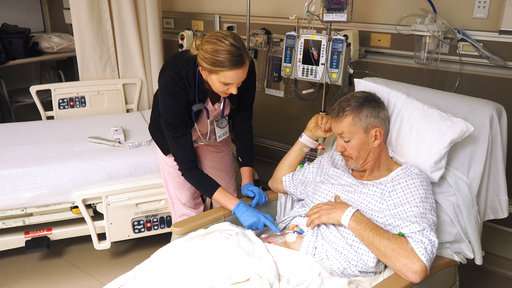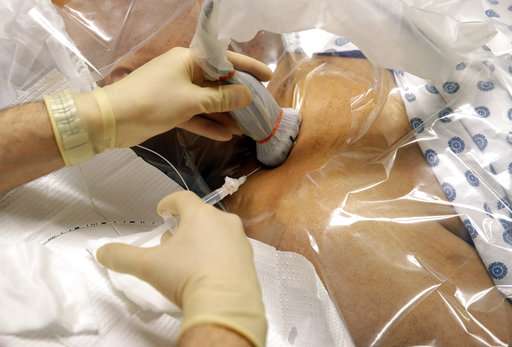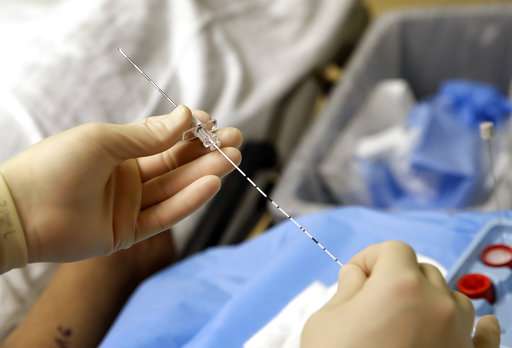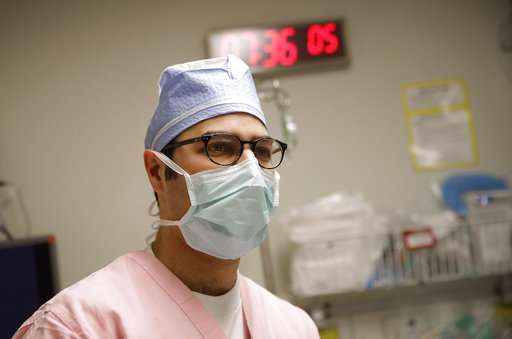Overcoming Opioids: When pills are a hospital's last resort

A car crash shattered Stuart Anders' thigh, leaving pieces of bone sticking through his skin. Yet Anders begged emergency room doctors not to give him powerful opioid painkillers—he'd been addicted once before and panicked at the thought of relapsing.
"I can't lose what I worked for," he said.
The nation's opioid crisis is forcing hospitals to begin rolling out non-addictive alternatives to treatments that have long been the mainstay for the severe pain of trauma and surgery, so they don't save patients' lives or limbs only to have them fall under the grip of addiction.
Anders, 53, from Essex, Maryland, was lucky to land in a Baltimore emergency room offering an option that dramatically cut his need for opioids: An ultrasound-guided nerve block bathed a key nerve in local anesthetic, keeping his upper leg numb for several days.
"It has really changed the dynamics of how we care for these patients," said trauma anesthesiologist Dr. Ron Samet, who treated Anders.
An estimated 2 million people in the U.S. are addicted to prescription opioids, and an average of 91 Americans die every day from an overdose of those painkillers or their illicit cousin, heroin.
This grim spiral often starts in the hospital. A Harvard study published in the New England Journal of Medicine in February raised the troubling prospect that for every 48 patients newly prescribed an opioid in the emergency room, one will use the pills for at least six months over the next year. And the longer they're used, the higher the risk for becoming dependent.

Doctors and hospitals around the country are searching for ways to relieve extreme pain while at the same time sharply limiting what was long considered their most effective tool. It's a critical part of the effort to overcome the worst addiction crisis in U.S. history but, as Anders' experience shows, their options are neither simple nor perfect.
Anders' excruciating injury eventually did require a low opioid dose when the nerve block wore off but, Samet said, far less than normal.
"Provide them with good pain relief initially, for the first 24 to 48 hours after surgery, the pain that comes back after that isn't necessarily as hard and as strong," said Samet, an assistant anesthesiology professor at the University of Maryland School of Medicine.
And some doctors are discovering an added benefit of cutting back or even eliminating opioids. At the University of Pittsburgh Medical Center, a program called "enhanced recovery after surgery" is getting some patients home two to four days faster following major abdominal operations, using non-opioid painkillers that are gentler on the digestive tract.
— Tips for finding opioid alternatives for surgical pain
— Science Says: Why are opioids so addictive?
"Our patients are very afraid of pain, especially the patients with a history of opioid addiction," said Dr. Jennifer Holder-Murray, a UPMC colorectal surgeon who helped start the program. "When they come back to me and tell me they didn't even fill their opioid prescription, that's a remarkable experience."
In trauma centers and surgery suites, there are no one-size-fits-all replacements for prescription opioids—narcotic painkillers that range from intravenous morphine and Dilaudid to pills including Percocet, Vicodin and OxyContin. They so rapidly dull severe pain that they've become a default in hospital care, to the point where it's not uncommon for patients to have an opioid dripping through an IV before they wake from surgery, whether they'll really need it or not.
Now, amid surging deaths from drug overdoses, some hospitals and emergency rooms are rethinking their own dependence on the painkillers, taking steps to make them a last resort rather than a starting reflex.

The new approach: Mixing a variety of different medications, along with techniques like nerve blocks, spinal anesthesia and numbing lidocaine, to attack pain from multiple directions, rather than depending solely on opioids to dampen brain signals that scream "ouch." It's known by the wonky name "multimodal analgesia."
Consider colorectal surgery, so painful that standard practice is to administer IV opioids in the operating room and switch to a patient-activated morphine pump right afterward. The University of Pittsburgh program ended that opioid-first mentality. Instead, doctors choose from a wide mix of options including IV acetaminophen and prescription-strength anti-inflammatory painkillers known as NSAIDs, anti-seizure medications such as gabapentin that calm nerve pain, muscle-relaxing drugs, and others.
Without the opioid side effects of nausea, vomiting and constipation, patients may find it easier to start eating solid food and walking around hours after surgery. Some do still need a low opioid dose, Holder-Murray cautioned, but few require a morphine pump. And for those who go home earlier, the approach can save hundreds, even thousands, of dollars.
"It's not just changing a medication or two. It's a whole culture change," she said.
At MedStar Georgetown University Hospital, anesthesiologist Dr. Joseph Myers is adding to his non-opioid cocktail a long-acting version of the numbing agent bupivacaine that's squirted into wounds before they're stitched closed. Called Exparel, it's controversial because it costs more than standard painkillers. But Myers said it lasts so many hours longer that he recently used it for a cancer patient who had both breasts removed, without resorting to opioids.
Hours after surgery, she was "eating crackers and drinking ginger ale and she says she's fine," he recalled.
At Stanford University, pain psychologist Beth Darnall says it's not just about using different medications. Patients who are overly anxious about surgical pain wind up feeling worse, so doctors also need to address psychological factors if they're to succeed in cutting the opioids.

In Baltimore, Anders remembers waking up in the University of Maryland's Shock Trauma Center and telling doctors and nurses, "I am a recovering addict." Years earlier, another car crash had led him to a pain clinic that prescribed Percocet "just like candy," Anders said.
Before getting addiction treatment, he said, "I came close to losing my job, losing my wife."
Samet, the anesthesiologist, estimates that Anders' nerve block cut by tenfold the amount of opioids he'd otherwise have received for his latest injury. Samet wheeled over a portable ultrasound machine, placed a probe over Anders' pelvis and searched the black-and-white screen for the dots that mark key nerves. He threaded a tiny tube directly to Anders' femoral nerve, allowing for repeated infusions of a non-addictive numbing medication for three days.
"It's like a Godsend. If you can have something like this, why would you want to take anything else?," Anders said a day after surgeons implanted a rod in his femur to fix the break. "I can wiggle my toes, I can move my foot, there's feeling right above the ankle," but in that damaged thigh, "I can't feel anything."
Patients need to ask about these kinds of alternatives, Samet said, but they're not available at all hospitals. Nerve blocks are becoming more common for elective bone surgery than in fast-paced trauma care, for example.
What Samet calls a lingering weak link: Even if patients go home with only a small supply of an opioid for lingering post-surgical pain, too often they get a refill from another doctor who assumes that prescription must be OK if a hospital chose it.
Not Anders. Sent home with some low-dose oxycodone, he discarded the last 20 pills.
"I didn't want them," he said, "and I didn't want nobody else getting their hands on them."
© 2017 The Associated Press. All rights reserved.


















